Sony SEL 10-18mm f/4 OSS is a wide angle
zoom lens for Sony NEX camera.
A wide – angle zoom lens for the Sony NEX
camera offers a quite wide angle equivalent to 15-27mm lens on a 35mm camera. The
lens can also be proud of its maximum aperture of f/4, image stabilization and
the price of $1,062.
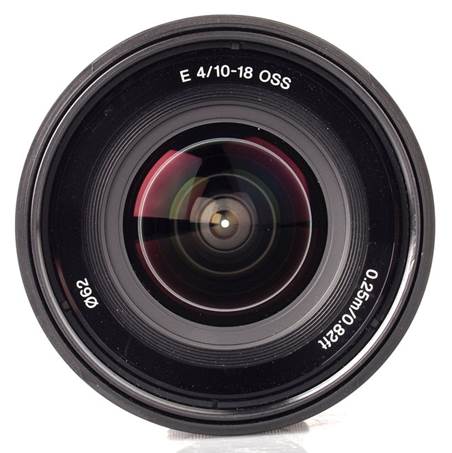
The
wide-angle zoom lens for Sony NEX camera
Handling and features
As it is built and designed typically for
Sony’s E-Mount lenses, most of its barrel is made of high quality black
plastics with a glossy finish and the lens mount is made of metal. For such
wide-angle lens, it is incredibly lightweight, tipping the scales at 225g.
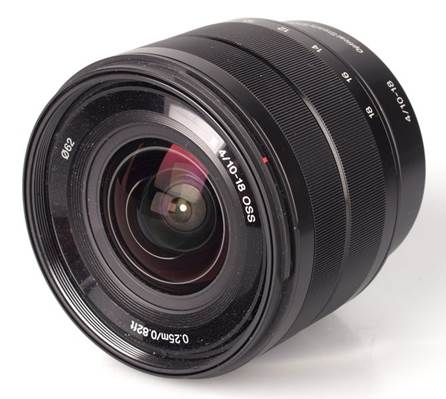
Fast
and reasonable focus
The lens features a reasonably fast auto
focus, but sometimes, it still struggles to focus accurately. This is more
obvious for subject with low contrast or in lowlight condition. The process of
adjusting manual focus is also very comfortable as the damped manual focusing
performs smoothly.
The minimum focus length is 25cm from the
sensor plane, which means it is ideal for shooting in narrow space, or for
making most of the distorted perspective wide angle lenses give when shooting
in a close distance.
As the lens does the focus internally, the
62mm filter ring does not rotate, which makes the lens very suitable for use
with graduated and polarizing filters. A standard petal-shaped lens hood is
given, coming with the lens via a bayonet fitting.
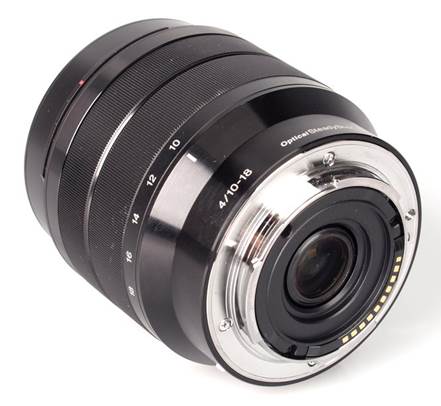
Auto
focus is performed internally
Although there are
main conflicts have been raised towards the usefulness of having optical image
stabilization on a wide angle lens like this, this feature gives a little more
leeway when shooting with slow shutter release speed. To be specific, in the
speed ranges as low as half a second around half the time at 10mm and ¼ of a
second at 18mm, sharp shots are likely.
Performance
At 10mm, we witness an excellent level of
sharpness in the center of the frame at f/4, although that of the frame’s edges
is a little bit disappointing by comparison, just falling off the good level. The
sharpness across the frame would be significantly improved when stopping the
aperture down to f/5, creating fabulous sharpness in the center and the edges’
clarity stops at excellent level.
The performance of aperture decreases
considerably at 14mm, where the center’s clarity is just good and that towards
the edges is fair. Stopping down to f/8 would bring a more improved performance
with wonderful sharpness in the center and good for the edges’ clarity. At
18mm, the lens also works in the same way.
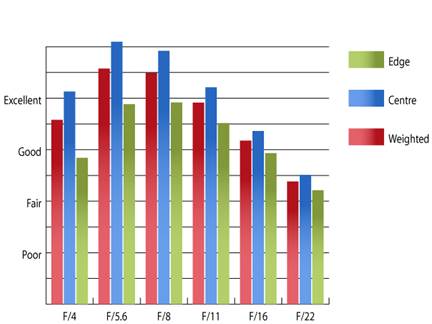
Resolution
at 10mm
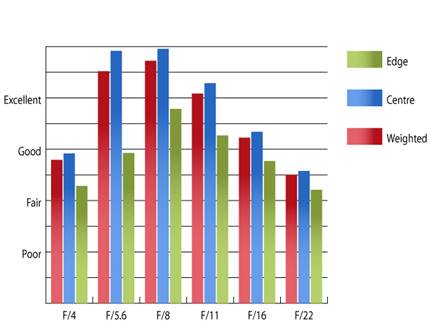
Resolution
at 14mm
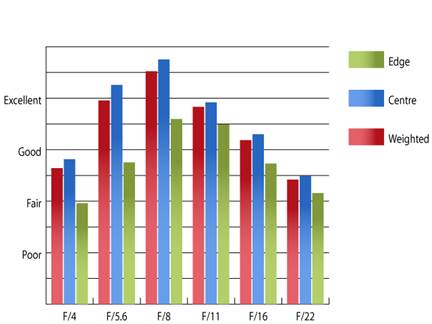
Resolution
at 18mm
How
to read the charts
Readings from the center of the frame in
different apertures are represented by the blue columns and the green ones
shows figures of the frame’s edges. The average of them is showed in the read
columns.
The indicator of the real resolution is
showed on the scale on the left. The higher the columns are, the better the lens
performs, as simple as that.
For this review, the lens is tested on a
Sony NEX-5R using Imatest.
It is recorded that chromatic aberrations
are well controlled. Rarely does it exceed three quarter of a pixel width at any
focal lengths and apertures. It just exceeds 0.75 pixel width for the edges’
clarity at 14mm. This level seems to be visible only along the high contrast
edges towards the frame’s edges.

Chromatic
aberration at 10mm
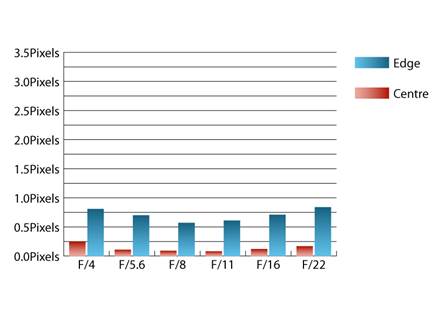
Chromatic
aberration at 14mm
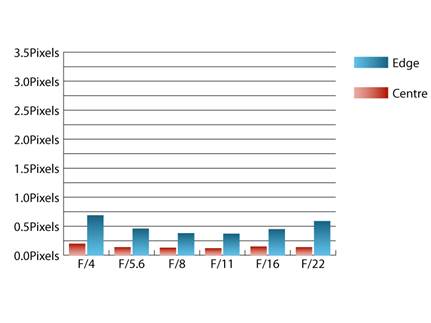
Chromatic
aberration at 18mm
The inability of the lens to focus on the
sensor or record all color of visible light at the same point is called
chromatic aberration. The stronger it is, the clearer the fringing or the halo
effect around sharp edges of the photo is. These effects can be eliminated by
software.
Apochromatic lens owns special lens element
(aspheric, extra-low dispersion etc.) can be used to minimize this issue. That
is why they are normally very expensive.
For this review, the lens is tested on a
Sony Nex-5R using Imatest.
It seems that declination of illumination towards
the frame’s corners is clearer than expected for such wide-angle lenses. At f/4
and 10mm, the corners are recorded to be 2.29 stops darker than the center and
this level reduces to 1.86 stops at 18mm. Even when the lens is stopped down to
f/11, it is still likely to catch some darkness in the far corner of some
shots. The illumination seems to never be visually consistent across the whole
frame.
For such lenses, the control of distortion
is very good with only 0.298% barrel distortion showed at 10mm and 0.219%
pincushion distortion recorded at 18mm. This distortion can easily be fixed by
image editor software, as it is uniform across the frame.
The lens hood fulfills its mission to
shield the lens from extremely strong light properly, preventing the
probability of getting flare. However, the lens is able to resist the flare and
retains good contrast when shooting into the light even without this hood.
Sample
photos

Wide
angle | 1/250 sec | f/6.3 | 10.0 mm | ISO 100

Telephoto
| 1/250 sec | f/6.3 | 18.0 mm | ISO 100

Closest
focus is 25cm | 1/160 sec | f/4.0 | 18.0 mm | ISO 100

Shooting
without the hood, the lens is still able to resist flare | 1/250 sec | f/4.0 | 10.0
mm | ISO 100

1/60
sec | f/4.0 | 10.0 mm | ISO 125

1/100
sec | f/5.6 | 17.0 mm | ISO 100

1/125
sec | f/4.0 | 10.0 mm | ISO 100

1/160
sec | f/6.3 | 10.0 mm | ISO 100
Value
Looking at the price tag of $1062, many
people might expect better performance at the maximum aperture than what this
lens actually provides.
Like an alternative selection, those who
own a Sony NEX system should also consider the Sony’s A-mount 11-18mm, which
costs about $607 and can use a NEX camera with the suitable adapter. Making an
extra payment for the adapter might only be rational for those who have already
had one of the A-mount lenses, and the result would be a bulky system,
worthwhile.
Conclusion
As long as the limit of the lens is kept in
its user’s mind, this lens will be able to create wonderfully high-quality
shots.
However, it is such a shame that the
maximum aperture between 14mm and 18mm does not achieve the same standard as
when the lens is stopped down.
Advantages
·
Good built quality
·
Performances are good when stopping down the
lens
·
Lightweight for a wide-angle lens
·
Less distortion
Disadvantages
·
Fair performance at the maximum aperture between
14 and 18mm
·
Some issues occurring in focusing accurately
under lowlight conditions and bad contrast
Verdicts
·
Features: 4.5/5
·
Handling: 4.5/5
·
Performance: 3/5
·
Value: 3/5
·
Overall: 3.5/5
Specifications
|
General
·
Lens mounts: Sony E Mount
Lens
·
Focal length: 10mm – 18mm
·
Angle of view: 76 – 109 degrees
·
Max aperture: f/4
·
Min aperture: f/22
·
Filter size: 62mm
·
35mm equivalent: 15mm – 27mm
·
Internal focusing: yes
Focusing
·
Min focus: 25cm
·
Stabilization: yes
Construction
·
Blades: 7
·
Elements: 10
·
Groups: 8
Box contents
·
Box contents: Front and rear caps, Lens hood
Dimensions
·
Weight: 225g
·
Height: 63.5mm
|